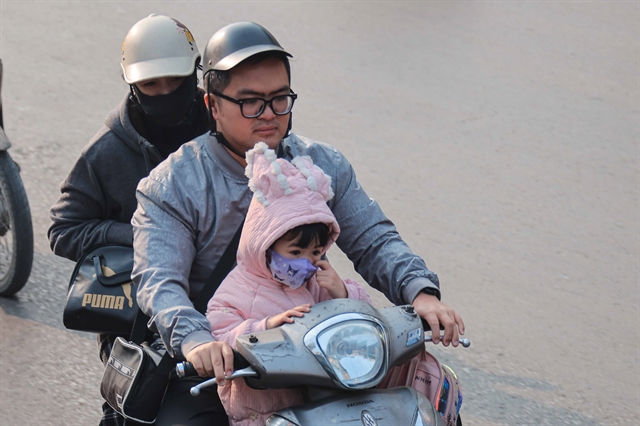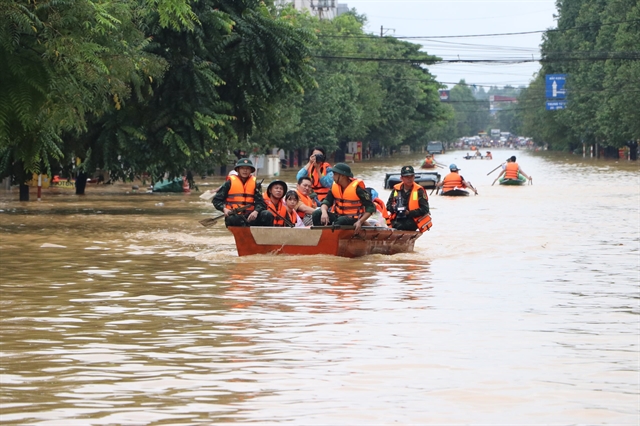 Society
Society
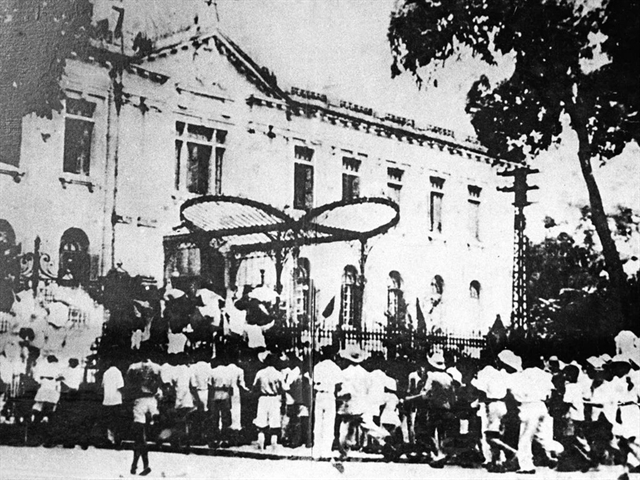
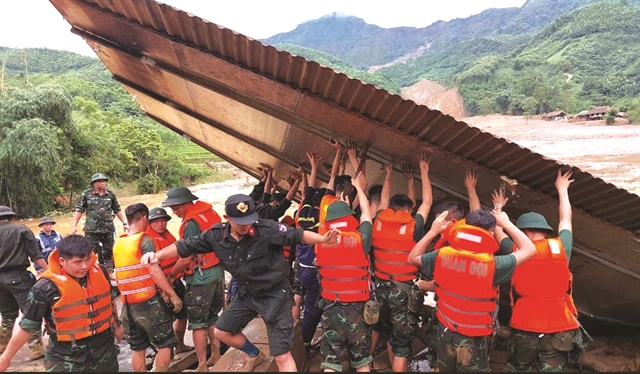 |
| Soldiers help recover the roof of a house in Lào Cai Province's Làng Nủ Village after a massive flood and landslide hit the area. VNA/VNS Photo |
by The Life Team
The golden autumn of the Northwest and Northeast has just started. Rice terraced fields in Y Tý District have only started to change colours, and in Tuyên Quang City, the country’s largest giant lantern parade lit up the streets since August until last Saturday. However, this week, news emerged of mountainous villages submerged by landslides and flash floods having devastated an entire hamlet in Lào Cai Province’s Bắc Hà District.
The main street in Tuyên Quang, where lantern carriages recently strolled, is now fully flooded, with boats running back and forth to deliver food aid or rescue people to take refuge in community centres.
Typhoon Yagi swept upward from the ocean across coastal provinces and cities of Quảng Ninh, Hải Phòng through Hà Nội up to Bắc Giang, then Lào Cai and other northwestern provinces . The path of the storm was closely monitored, followed and its tiniest move recorded and broadcasted loud and faraway to the remote communities thanks to mobile phone system and social media network, Facebook, in particular. The time, course and duration of the storm could be measured as it arrived. But its horrendous devastating aftermath continues even days after the storm was weakened into a low.
The post-typhoon losses spread downhill from rain in the upstream as flashfloods and landslides rushed down. Water threatened hydropower plants' dams, and raised water level submerged valleys and cities, even big towns. By 7am September 12, 325 people were killed or missing, a total acreage of 250,000 ha of rice and vegetables were destroyed, nearly 190,000 houses damaged, more than 1.5 million domestic poultry and cattle were killed, and more than 1,800 cages and fish farms were washed away.
And the list doesn't end there.
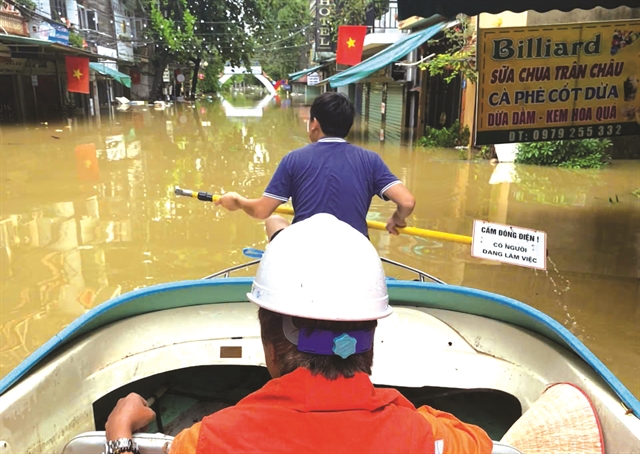 |
| KEEPING AFLOAT: Officials from the Tuyên Quang City Electricity Department, by boat, inspect the power supply response for residents. Photo Tuyên Quang Newspaper |
The super typhoon Yagi has destroyed what everyone hoped would be a good harvest after a year of hard work.
LÀO CAI: Warm hearts during the flood in Lào Cai, the most devastated place
The spirit of solidarity and mutual support of the Vietnamese people has once again been demonstrated, as floods and landslides continue to batter Lào Cai—one of the most affected localities in the northern mountain region as a result of Typhoon Yagi.
With danger increasing in many areas across the province due to continuously severe weather conditions, local authorities, functional forces, social organisations, and individuals have joined hands to support those affected by the floods.
Among the pioneering forces involved in rescuing and evacuating people to safe shelters were the provincial police and soldiers.
Colonel Cao Minh Huyền, director of the Provincial Police Department, visited the scene to direct the rescue forces in helping locals move their property out of the flooded houses.
The senior police officer, along with hundreds of others, helped people in many residential areas across Lào Cai, as the city was seriously flooded after water levels in the Red River rose.
Traffic police were also deployed to build makeshift buoy bridges on submerged roads, helping people and vehicles travel safely and preventing them from entering deeply affected areas.
Particularly tragic was a landslide in Làng Nủ Village, Bảo Yên District, on Tuesday. The entire area was submerged under mud and water, and more than 600 people participated in rescue and recovery efforts, including young volunteers, police, healthcare workers, and especially 300 soldiers from Military Region 2.
The village, home to 37 households with 158 people, was partly buried. At least 30 people were found dead, while dozens remain missing, according to a report from the Lào Cai newspaper on Wednesday.
Roads were cut off, and communication lines were damaged, making the search for survivors especially challenging. Nonetheless, rescuers have been working tirelessly to locate the missing.
Earlier, on Sunday, a massive landslide also swept through Hòa Sử Pán 1 Village in Mường Hoa Commune, Sa Pa Town, causing heavy damage to people and property.
Teacher Nguyễn Viết Thuyết, principal of Sử Pán Primary Boarding School, described the devastation: "The consequences of the landslide were very serious. Five people died, one was missing, and nine others were injured after the terrible landslide..."
To support affected residents and ensure their safety during the storm and floods, Thuyết and other teachers urgently advised villagers from other areas, particularly Hòa Sử Pán 1, to move to the school, which has been used as a temporary shelter until the floods subside.
The teachers prepared facilities, accommodation, and meals for those seeking refuge.
In just one day, over 100 villagers came to the school for shelter.
Along with the teachers of the boarding school, many homestays and motels in Mường Hoa Commune also joined hands to provide safe places for people in flooded areas and tourists stranded by the rising waters.
In the centre of Sa Pa Town, numerous motel and hotel owners offered free accommodation to flood victims and tourists stranded in the town.
Responding swiftly to reports from other communities, authorities in Bắc Hà District evacuated nearly 200 people to a cultural community centre after cracks appeared in the walls of their homes.
HÀ GIANG: Heavy rain causes landslides, isolating many roads
 |
| GO WITH THE FLOW: Extended heavy rain and flooding have caused widespread inundation in many areas of Bắc Quang District, Hà Giang, making travel and transport difficult for local residents. VNA/VNS Photo Minh Tâm |
As of September 10, constant heavy rains and floods have caused landslides across Hà Giang Province, resulting in significant damage to homes and crops. Key roads have been cut off and isolated, preventing vehicles from passing through.
According to the Hà Giang Provincial Steering Committee for Disaster Prevention and Search and Rescue, 713 households have been affected by the heavy rains. Of these, 14 homes required urgent evacuation, six homes were completely buried, 111 homes were impacted by landslides, seven homes were swept away by floodwaters, 89 homes suffered roof damage from fallen trees, and 486 homes were flooded.
Additionally, over 1,100 hectares of rice, corn, and other crops have been damaged; more than 26 hectares of forestry crops and aquaculture were affected, and more than 4,500 poultry were lost. Prolonged heavy rain has caused landslides, blocking many irrigation channels in Yên Minh and Bắc Quang districts.
More seriously, roads throughout the province have been affected by landslides, making it impossible for vehicles to pass through. There are four landslide sites in Bắc Mê District, leaving vehicles stranded. Numerous inter-village roads have also experienced landslides and flooding, causing significant traffic congestion.
Flooding has submerged one secondary school in Đồng Yên, Bắc Quang, two kindergartens in Xín Mần, and one school each in Vị Xuyên and Mèo Vạc.
According to Vũ Thế Phương, deputy chief of the Office of the People's Council - People's Committee of Hoàng Su Phì District, Typhoon Yagi and its circulation have severely impacted local tourism as well.
“As of now, no tourists are reported to be stranded in the area. However, heavy rainfall caused by the storm’s circulation has led to landslides, and many tour groups have had to cancel their trips,” Phương told Việt Nam News.
Local authorities are providing support and guidance to residents, helping them safely navigate through vulnerable and landslide-prone areas. Authorities are working to stabilise the situation as soon as possible.
In Hoàng Su Phì, a 14-year-old girl was rescued after a landslide buried a five-room stilt house in Dì Thàng Village, Bản Nhùng Commune, on September 9.
The District Military Command quickly mobilised soldiers and local militia for search and rescue, successfully rescuing the girl and transporting her to the commune health station for emergency care.
Efforts are still underway to search for a six-month-old baby missing after the landslide. The search has been hindered by heavy rain, large amounts of debris, and power outages.
Local authorities have visited the affected families and offered financial support, while continuing their search for victims.
The Hà Giang Provincial Meteorological and Hydrological Station has warned that heavy rain will persist in the coming days.
Trần Quang Bằng, chairman of Hoàng Su Phì District’s People’s Committee [Administration], said the locality would continue to disseminate disaster prevention information and warnings to all citizens.
“During the rainy season, local authorities must spread information about the impacts of natural disasters and methods for prevention among the communities," Bằng said.
“Families living in high-risk areas are being encouraged to relocate to safer places to avoid further loss of life and property. Five households whose homes collapsed have been supported with VNĐ150 million (VNĐ30 million per house). We are also mobilising excavators to clear roads and ensure traffic flow. For crops, we’ve directed villagers to urgently harvest fallen rice to minimise further damage,”
YÊN BÁI: 11,400 households evacuated, houses collapsed, and more than 4,500ha of crops lost
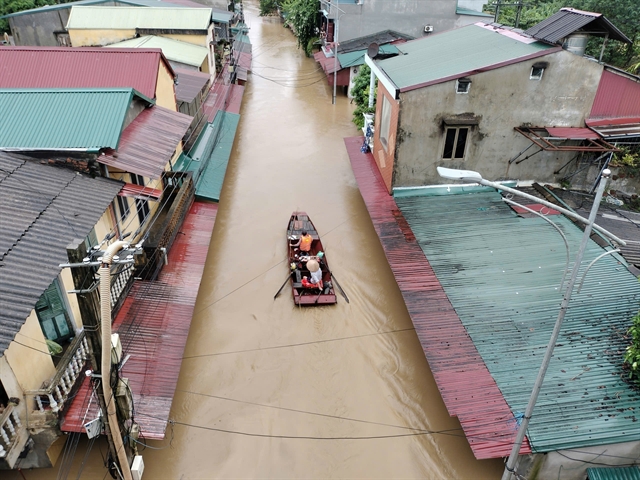 |
| WATERLOGGED: Rescue forces evacuate residents from a flooded area on Thanh Niên Street, Hồng Hà Ward in Yên Bái Province. VNA/VNS Photo Tuấn Anh |
Floods and landslides in Yên Bái have caused heavy losses, with the province suffering an estimated VNĐ195 billion in damage, according to the provincial Steering Committee for Natural Disaster Prevention and Search and Rescue. Yên Bái City, along with districts such as Trấn Yên, Lục Yên, Văn Chấn, and Văn Yên, have been the most affected.
More than 22,000 houses have been damaged, and 102 were completely destroyed. Nearly 3,000 hectares of rice and 1,000 hectares of corn and vegetables have been severely damaged.
The floods have also killed more than 10,000 poultry and 15 cattle, and 170 hectares of fish farms have been washed away.
In response, the Chairman of Yên Bái’s People’s Committee declared a provincial state of emergency.
Many roads connecting hamlets and villages were destroyed, and bridges were washed away, leaving remote areas completely inaccessible. Over 30 schools and local offices were submerged, electricity grids were knocked out, and more than 20 mobile phone centres could not generate signals, hampering rescue efforts even further.
A combined force of 199 soldiers, 1,328 local militiamen, and over 9,300 people from various sectors was mobilised for search and rescue missions. Hundreds of vehicles were deployed to clear landslides and rescue those trapped in flooded and remote communities.
Despite the massive rescue efforts, many areas remain without power, and the lack of communication signals has left many people in lowland cities putting up signs asking for help, whether to check on elderly relatives or families with young children, request food relief, or arrange transport out of the flooded areas.
THÁI NGUYÊN: Local people lend a helping hand to flood victims
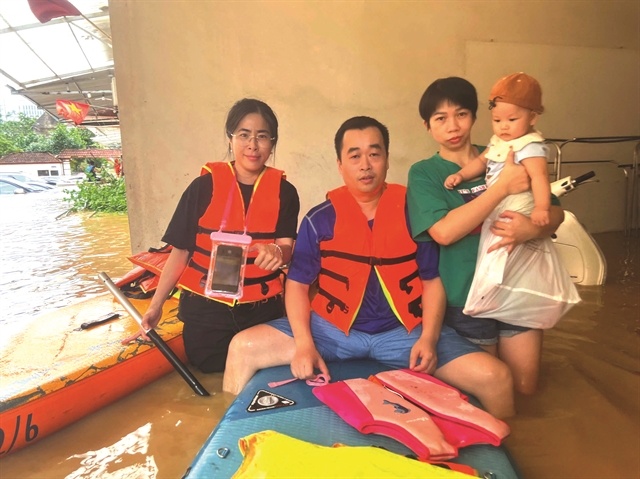 |
| READY TO FLEE: Nguyễn Thị Việt (left) uses her paddleboard to evacuate people in flood-hit Quang Vinh Ward to a safe location. Photo coutersy of Nguyễn Thị Việt |
Nguyễn Thị Việt and her husband never thought their sporty paddleboards would be useful for rescuing flood victims in Quang Vinh Ward, Thái Nguyên Province.
Floodwaters rose dangerously high in the ward, and rescue forces were overwhelmed by a lack of boats. Việt, who works at Thái Nguyên Central Hospital, received a call for help from her friend Trần Tuấn on Monday morning. Tuấn, his wife, and their 12-month-old baby were stranded on the third floor of their building, as water levels had reached the second floor and were 8 to 9 metres deep.
Việt, her sister, and a male colleague used three paddleboards to evacuate Tuấn’s family and five other families in a three-hour rescue operation.
They also used the paddleboards to carry clean water and instant noodles to people trapped on upper floors.
“I’ve never seen such heavy flooding in the city,” Việt said. “There aren’t enough rescue boats, but paddleboards can still move safely when the water is calm.”
Quang Trung High School teacher Ngọc Xuân’s house in Quang Trung Ward was not flooded, so Xuân and her husband opened their home to those in need.
They moved their family into one room and used the remaining three rooms to accommodate flood victims. Xuân was ready to help with cooking, cleaning, and looking after children.
After posting her phone number and address on social media, she received calls from people seeking shelter within 30 minutes.
“We want to help as many people from the flood-hit areas as possible,” Xuân said.
Meanwhile, Đặng Minh Đức, whose home in Phúc Tân Commune, Phổ Yên District, was not affected by the floods, worked with charity groups on social media to coordinate rescue efforts.
“I have two years of experience teaching swimming and a rescue training certificate, so I thought I could help,” Đức said.
After posting on social media, Đức received many messages from people wanting to join the rescue effort. He and a friend went to Bến Tượng Bridge—the largest bridge in the province across the Cầu River—and joined soldiers working to dam the floodwaters.
At all levels, the provincial Youth Union has proactively mobilised social sectors to donate food supplies to those in need.
Youth Union member Nguyễn Hoàng Đại from Tân Lập Ward said: “The flood victims are elderly people, children, and pregnant women. When we see them, we don’t have time to think much.”
“We just do our best to get people out of danger as quickly as possible.”
According to the National Steering Committee for Natural Disaster Prevention, Search and Rescue, as of the morning of September 11, 3,063 households had to be urgently relocated; 323 homes had their roofs blown off, over 7 million hectares of rice and other crops were damaged, and 415 hectares of forest were destroyed.
Additionally, nearly 256,000 cattle and poultry died. The total value of property damage is estimated to be more than VNĐ195 billion (roughly US$8 million).
HÀ NỘI: 4,000 people relocated to community centres
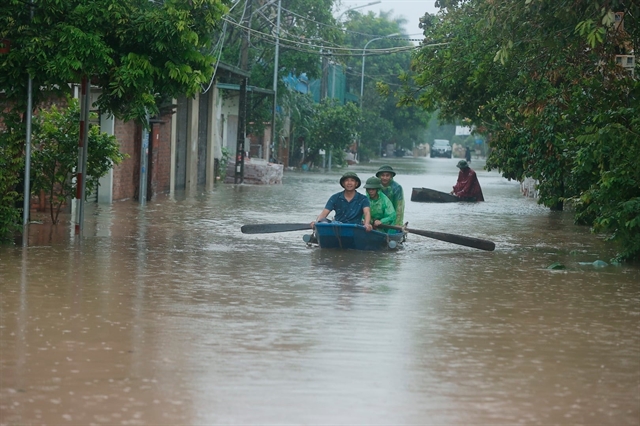 |
| URBAN RIVER: Due to flooding, local people at Liệp Mai Village, Ngọc Liệp Commune, Quốc Oai District, Hà Nội have to travel by board. VNA/VNS Photo Minh Quyết |
In Hà Nội, floods along the Red River have caused some areas outside the dykes in Hoàn Kiếm, Tây Hồ, and Ba Đình districts to become inundated, but the city centre remains unaffected.
Water levels in the Bùi and Tích rivers have also risen, causing localised flooding in outlying districts such as Ứng Hòa, Chương Mỹ, Hoài Đức, and Mỹ Đức. Chương Mỹ is expected to experience prolonged flooding due to high water levels in the main rivers, which are impeding drainage.
Forecasts indicate that the Red River’s water level will stay below alert level three, and it is expected to stabilise, depending on rainfall and the release of water from hydroelectric reservoirs.
"Even if the floodwaters reach level three—the highest alert level—they will not flood downtown Hà Nội due to the Red River dyke system," said Mai Văn Khiêm, director of the National Centre for Hydro-Meteorological Forecasting.
Local authorities have begun evacuating residents as a precaution against rising water levels.
Phạm Tuấn Long, head of Hoàn Kiếm district authorities, has requested the evacuation of around 130 families, totalling nearly 500 people. They will be temporarily relocated to The One apartment complex, with Hàng Bè market prepared as a backup shelter.
He also called for a review of other public buildings for potential use as evacuation centres.
Some social work experts noted that essentials such as food, water, or hygiene items are less of a priority in Hà Nội, given the city’s well-developed logistics system.
Instead, public support for clean-up and reconstruction efforts following the flood will be more crucial to help residents return to their normal lives.
Help in any way you can
If you wish to help, direct your goodwill appropriately. Instead of rushing to the scene, coordinate with local police stations or district chapters of the Motherland Front to donate essentials like food, clothes, sanitary pads, first aid kits, bottled water, healthy snacks, milk buns, and bread. Avoid instant noodles, as many flood-hit areas lack cooking facilities. VNS



.png)



.jpg)
